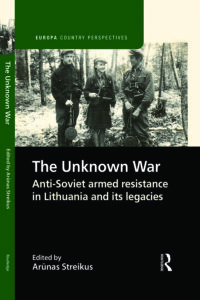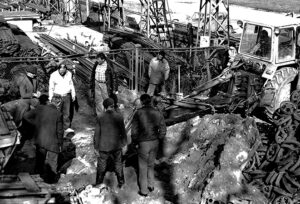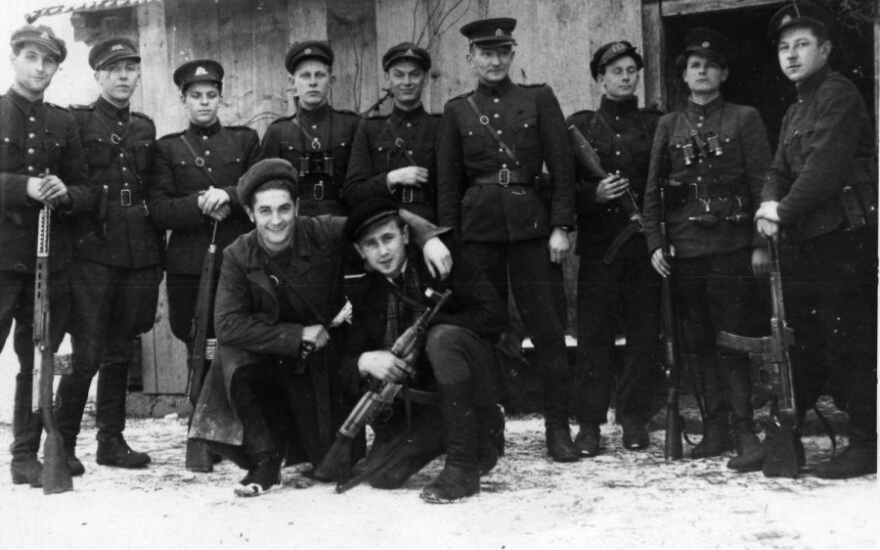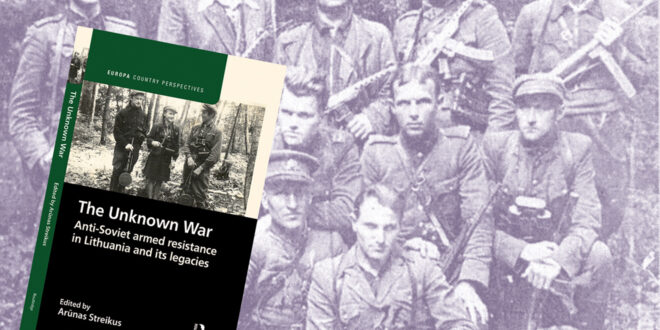Victor Nakas.
Once upon a time, thousands of people, mostly men, decamped deep into Lithuania’s forests. They established underground bunkers from which they would emerge to battle Soviet troops tasked with occupying and pacifying the country. Initially, these “forest brothers” (miško broliai) succeeded in making large areas of the countryside unsafe for the invaders. For years, they fought valiantly but eventually were overcome by their foes’ superior numbers and firepower. Thousands died defending their country.
That, in a nutshell, is likely how many Baby Boomers (born between 1946 and 1964) in the Lithuanian diaspora recall the partisans who battled the Soviets from 1944 to 1953. It’s what they were taught by their parents, their teachers at Lithuanian Saturday schools, and their counselors at summer camps. Much of what they learned came from the memoirs of partisan leader Juozas Lukša-Daumantas, who wrote about the early years of the armed resistance (he was later killed by the Soviets).
Their view of the partisans may have been romanticized; certainly, it was incomplete due to the difficulty of obtaining information from behind the Iron Curtain. But the Boomers knew of this war and its importance.

Fills Historic Void
That is more than can be said for the general public and most scholars in the West. Several months ago, British publishing giant Routledge produced a book by scholars at Vilnius University titled The Unknown War: Anti-Soviet armed resistance in Lithuania and its legacies. In the first sentence of the Introduction, the book’s editor, Arūnas Streikus, explains that the armed resistance to the Soviet re-occupation of the Baltic states and Galicia in 1944 “has yet to become established in the common narrative of contemporary European history.” To paraphrase less diplomatically, he seems to be saying, “Pay attention to this blank spot of history that our book fills in.”
The book is divided into two parts, each containing three chapters. Part I, “A Strange Long War,” focuses on the history of the resistance movement itself, i.e., on what happened. Part II, “From the Memory War to the Heroic Narrative,” explores the legacies of the war, i.e., how it was remembered and commemorated.
Response to Soviet Terror
Kęstutis Girnius, the author of the first chapter, “Lithuanian anti-Soviet armed resistance in the context of XXth-century partisan wars,” grew up in the Lithuanian diaspora and is the author of Partizanų kovos Lietuvoje (Partisan Battles in Lithuania), published in Chicago in 1987. Judging from Streikus’s assessment, the 1987 Girnius monograph continues to be a seminal work on Lithuania’s armed anti-Soviet resistance. He credits Girnius with formulating the theory, now well established in Lithuanian historiography, that Soviet terror was the key reason for the partisan war; with demonstrating that in the universe of internal wars, Lithuania’s belongs to the category of a “small scale war waged against a foreign occupying force”; and with applying a comparative analysis to Lithuania’s war. Girnius’s chapter in the new book updates his earlier work with empirical data that was unavailable then and delivers it in English, apparently for the first time.
In Context of History

He compares the Lithuanian war to armed resistance against the Nazis in Belgium, Denmark, France, the Netherlands, and Yugoslavia, and against the Soviets in Estonia, Latvia, and Ukraine. The singular importance of this analysis is that it puts Lithuania’s war in context, inviting scholars in other countries to recognize where it fits in the overall history of wars and resistance movements.
Dainius Noreika is the first of four young historians whose contributions appear in the book. “Who were the Lithuanian partisans?” is his chapter’s title. He is well-positioned to answer the question. Noreika has performed yeoman’s work by compiling a database of biographical information on 1,000 partisans drawn from archives in Lithuania encompassing the periods of independence and occupation.
His study has yielded many insights about those 1,000 fighters. Fully 99 percent of them lived the bulk of their lives in independent Lithuania. Noreika argues that the experience of having to take up arms between 1918 and 1920 to establish the modern Lithuanian nation-state created a culture of patriotic paramilitarism, personified by the Lithuanian Riflemen’s Union (Lietuvos šaulių sąjunga), that heavily influenced the partisan movement.
From Rural Stock
Noreika’s data reveals that an absolute majority of the partisans were farmers.. Up to 88 percent of them were attached to armed units that operated in the counties where their homes were located. They fought alongside friends and relatives — 39 percent of them with at least one sibling.
He marshals the data to carefully examine the Soviet narrative that the partisan movement was the brainchild of the Nazi and, later, Western intelligence services. To the contrary, he finds that only 0.2 percent of partisans were trained by those services. He also uses data to dismantle the accusation that partisan leaders and large numbers of fighters were involved in the Holocaust (he also identifies the culpable ones).
In “Partisan supporters: The unseen participants in the resistance,” Enrika Kripienė examines the role of Lithuanians who did not take up arms but nonetheless performed vital support functions. Per Kripienė, the number of armed fighters (50,000) was equal to the number of individuals in support roles. She describes several types of sympathizers. One was the couriers who delivered messages within the partisan network. Kripienė maintains that these messengers, many of them women, provided the essential links necessary for a centralized resistance network. Without supporters who served as couriers and provided reconnaissance, food, shelter, and the like, “the resistance would have been different — neither as long nor as centralized, nor as massive in scale.”
Memory of Armed Resistance
It may come as a surprise for readers to learn that, following the implosion of the U.S.S.R., “the memory of the partisan war was initially marginalized in Lithuanian society during the first two decades of restored independence.” So states Mingailė Jurkutė in “The memory of the armed anti-Soviet resistance during the Cold War.” A rebirth of interest in the partisans occurred around 2009, spurred by a new generation of Lithuanians. And yet, she asserts, even to the present day, political groups devote insufficient attention to the legacy of the partisans.
Why this occurred is addressed her chapter. She traces how the Soviet memory policy toward the partisans began with silence — discussion of the resistance was a state secret — and later evolved to targeted propaganda based on falsehoods. The bulk of Jurkutė’s analysis is devoted to the Soviet narrative, which she characterizes as suppressed memory.
Diaspora Connection
Among the contributors to the book, she is the only one to devote a section of her chapter to the diaspora’s connection to the partisan conflict. The diaspora narrative of the war, she says, is a case of obstructed memory hindered by distance and lack of information. While she credits the diaspora with a significant role in preserving and disseminating the memory of the partisan war, she concludes that in its collective memory, the armed struggle occupied a place of secondary importance. She bases her analysis on emigre literature. In addition, she cites a single source to assert that the Baby Boomer generation of diaspora Lithuanians “had only a passing understanding” of the partisans.
Further scholarly research might temper these assertions. Baby Boomers like me who attended Lithuanian Saturday school would have learned there about the partisans. This information would have been reinforced at the summer camps run by the Ateitis Federation and the Lithuanian Scouts Association, the two major ideological youth organizations in the post-war emigre community. Scouts would sing partisan songs around the campfire. One group built a partisan bunker on their camp grounds and would celebrate Christmas Eve there. At the Ateitis camps, typically, one evening would be devoted to the partisans; it featured songs, prayers, solemn readings, and an outdoor candlelight procession. For me and, I surmise, for others, the emotional impact of these rituals was neither negligible nor transitory.
After Lithuania began its move toward independence in August 1987, grassroots organizations led by Boomers sprang up around the United States. They were among the most enthusiastic and insistent proponents of freedom for Lithuania, a pain in the neck for the White House, which favored Soviet leader Mikhail Gorbachev over Lithuania. It would be worthwhile to explore whether there was a nexus between these Boomers’ political activism and their learned memory of the partisans’ heroism and sacrifice. But to do so, one would need to go beyond the sources Jurkutė consulted by studying Lithuanian school curricula and conducting surveys, interviews, and oral histories.
Current Focus
As the title of her chapter “The partisan war in Lithuanian memory culture after 1990” indicates, Aistė Petrauskienė takes up where Jurkutė leaves off. Unsurprisingly, after the Cold War, the initiative for commemorating the partisans came from those closest to the armed resistance. Ten organizations representing former political prisoners and deportees engaged in these efforts in the early years of restored independence. They focused on the fallen fighters themselves. There were two unfortunate consequences of this. First, reburials of partisans were conducted in a haphazard way. Petrauskienė calculates that 95 percent of partisan remains were unearthed without the involvement of specialists. Second, a preoccupation with the fallen came to predominate over other important aspects of the war. In the listing of Lithuania’s Cultural Registry, 89 percent of all partisan war sites were associated with death: graves, cemeteries, and death sites. The emphasis was on partisans as victims. Other sites, such as bunkers, camps, and farmsteads, were marginalized.
For this, Petrauskienė faults Lithuanian state institutions, which followed the lead of non-governmental organizations instead of establishing and implementing a balanced and more comprehensive commemoration of war sites.
Complicating these efforts was ambivalence by political forces regarding the partisan war. When the government was led by a right-wing majority, due attention was paid to the partisans’ contributions. For ideological reasons, the left’s preference was to ignore the partisans. When it was in power, no new initiatives were implemented. However, the left did not attempt to undo measures adopted by the right when the latter was in the majority. According to Petrauskienė, it was not until 2008 that the right and left came to a unified position on the partisan war.
Renewed Interest
At roughly the same time, a new generation of Lithuanians, born after 1990, began to show significant interest in partisan war sites, participating in field trips and educational activities. In this, they were the heirs of the former political prisoners and deportees. The generation between these two groups, raised in a post-Stalin Soviet culture and heavily influenced by it, adopted a neutral position on the war.
Bunker Archeology

In “Archaeology in the study of the Anti-Soviet Lithuanian partisan war,” Gintautas Vėlius is bluntly critical of spontaneous efforts to uncover and rebury partisans, observing that “more than 99 percent of partisans killed in battles were essentially exhumed and buried illegally.” In the process of reburying the remains of approximately 2,000 partisans, much valuable information was lost. By contrast, only 11 remains were exhumed with the benefit of archaeological investigations. Applying the methods of forensic archaeology, specialists have had more success uncovering and identifying the remains of 52 partisans executed in Soviet prisons and buried secretly, amidst “legal” graves, in locations in the Vilnius area. In contrast to exhumation of partisans at war sites, an effort which seems to have run its course, the work of locating the remains of partisans executed in prisons remains unfinished. According to Vėlius, the burial sites of 182 incarcerated partisans murdered between 1950 and 1952 are unknown.
Vėlius also devotes attention to partisan bunker archaeology, providing interesting information highlighted by diagrams. He provides two insights that challenge stereotypes that might still exist among diaspora Lithuanians. First, the partisans did not initially reside solely in isolated underground bunkers. Before 1946, they lived in large camps that contained trenches and bunkers. As time went on, the outnumbered partisans moved to underground shelters. Second, the bunkers weren’t exclusively dug in the forests. They were also located on farms, under buildings, inside wells, and in riverbanks, cemeteries, and churchyards.
The Unknown War is a relatively short book (174 pages). Though intended primarily for scholars, it is easily accessible to a general audience, thanks to the fluid translation by Darius Sužiedėlis, an experienced Lithuanian-American translator. I found only a few sentences that were indecipherable either because of academic jargon or problems with copyediting.
This book will be eye-opening to people who know nothing about Lithuania’s armed anti-Soviet resistance and those whose knowledge relies heavily on Lukša-Daumantas’s memoirs and knowledge gained in Lithuanian schools and camps. For the latter group, the three chapters in Part II may be particularly revelatory. This review barely scratches the surface of the rich detail and wealth of analysis provided by each of the book’s contributors.
Young Historians
As previously noted, four of the six contributors are young historians (three Ph.D.s and one doctoral student). The existence of this new generation of scholars bodes well for many years of additional research that will add to the body of knowledge related to Lithuania’s anti-Soviet resistance. Let’s hope that much of it continues to reach an English-speaking audience.
As is often the case with academic works that do not reach a large audience, The Unknown War is pricey. The hardback is available on Routledge’s website for $128. The e-book sells for $47.16.
For those prices, one would expect the book to be pristine. Alas. Nowadays, one is accustomed to finding a handful of errors in newly published books. In this one, I counted more than 25 mistakes. Some would not be picked up by relying on a spellcheck program (e.g., “one side or the either”). Others, it is to be hoped, were caused by software gremlins in the process of laying out the text for the electronic book version (which is the one I read). There are multiple instances of text being jammed together without necessary spaces between words, numbers, and symbols. A proper name used by partisans, Ąžuolas (oak), is rendered four times as “žuolas”. There are other mistakes (e.g., “4,000 were wounded 4,000”) which give the impression that no competent copyeditor read the text before it was published. It‘s perplexing that Routledge, a company founded in 1836 that claims to be “the world‘s leading academic publisher in the Humanities, Social Sciences, and STEM,” would fail to ensure basic quality control.
Notwithstanding this annoyance, The Unknown War is an enlightening book that broadens and deepens our understanding of the partisan war and its echoes in Lithuanian society decades after the fact. I highly recommend it.

The article was published in “Draugas NEWS”, October 2022 edition.
 DRAUGAS NEWS Lithuanian World Wide News in English
DRAUGAS NEWS Lithuanian World Wide News in English
